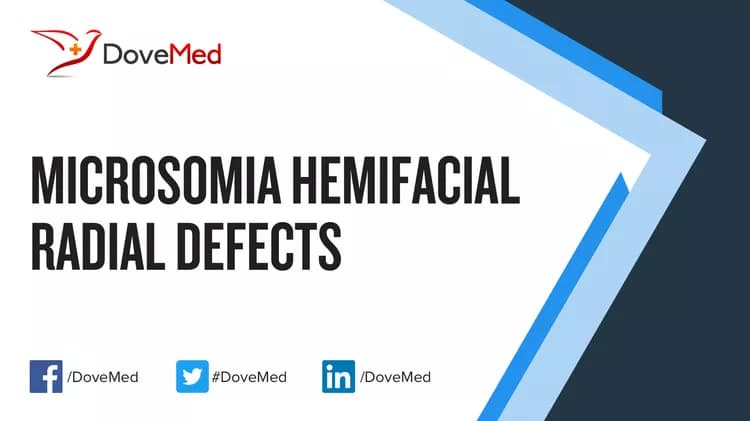What are the other Names for this Condition? (Also known as/Synonyms)
- Goldenhar Syndrome with Ipsilateral Radial Defect
- Moeschler Clarren Syndrome
- Oculoauriculovertebral Spectrum with Radial defect
What is Microsomia Hemifacial Radial Defects? (Definition/Background Information)
- Microsomia Hemifacial Radial Defects Syndrome, or Oculoauriculovertebral Spectrum (OAVS) with Radial Defects, is a rare branchial arches and limb primordia development disorder characterized by variable degrees of uni- or bilateral craniofacial malformation and radial defects that result in extremely variable phenotypic manifestations
- Characteristic features include low postnatal weight, short stature, vertebral defects, hearing loss, and facial dysmorphism (incl. facial asymmetry, external, middle, and inner ear malformations, orofacial clefts, and mandibular hypoplasia)
- These features are invariably associated with radial defects, such as preaxial polydactyly, thumb and/or radius hypoplasia/agenesis, or triphalangeal thumb
- Cardiac, pulmonary, renal, and central nervous system involvement has also been reported
(Source: Oculoauriculovertebral Spectrum with radial defects; Orphanet, National Institute of Health and Medical Research (INSERM), Paris.)
Who gets Microsomia Hemifacial Radial Defects? (Age and Sex Distribution)
- Microsomia Hemifacial Radial Defects Syndrome is a rare congenital disorder. The presentation of symptoms may occur before or after birth
- Both males and females may be affected
- Worldwide, individuals of all racial and ethnic groups may be affected
What are the Risk Factors for Microsomia Hemifacial Radial Defects? (Predisposing Factors)
- Currently, no risk factors have been clearly defined for Microsomia Hemifacial Radial Defects Syndrome
It is important to note that having a risk factor does not mean that one will get the condition. A risk factor increases one’s chances of getting a condition compared to an individual without the risk factors. Some risk factors are more important than others.
Also, not having a risk factor does not mean that an individual will not get the condition. It is always important to discuss the effect of risk factors with your healthcare provider.
What are the Causes of Microsomia Hemifacial Radial Defects? (Etiology)
The exact cause of Microsomia Hemifacial Radial Defects Syndrome is not known at the present time.
What are the Signs and Symptoms of Microsomia Hemifacial Radial Defects?
The signs and symptoms of Microsomia Hemifacial Radial Defects Syndrome may vary in type and severity among affected individuals, and include:
- Complete duplication of thumb phalanx
- Hemifacial hypoplasia
Very frequently present symptoms in 80-99% of the cases:
- Aplasia/hypoplasia of the thumb
- Facial asymmetry
- Laryngeal stridor
- Microtia
- Short mandibular rami
Frequently present symptoms in 30-79% of the cases:
- Abnormality of the middle ear ossicles
- Atresia of the external auditory canal
- Atrioventricular canal defect
- Cognitive impairment
- Distal urethral duplication
- EMG: Myopathic abnormalities
- Preauricular pit
- Preauricular skin tag
- Renal hypoplasia/aplasia
- Sensorineural hearing impairment
- Short stature
- Vesicoureteral reflux
Occasionally present symptoms in 5-29% of the cases:
- Aplasia/hypoplasia affecting the eye
- Aplasia/hypoplasia of the lungs
- Conductive hearing impairment
- Ectopic anus
- Non-midline cleft lip
- Preaxial hand polydactyly
- Triphalangeal thumb
- Wide mouth
(Source: Microsomia Hemifacial Radial Defects; Genetic and Rare Diseases Information Center (GARD) of National Center for Advancing Translational Sciences (NCATS), USA.)
How is Microsomia Hemifacial Radial Defects Diagnosed?
Microsomia Hemifacial Radial Defects Syndrome is diagnosed on the basis of the following information:
- Complete physical examination
- Thorough medical history evaluation
- Assessment of signs and symptoms
- Laboratory tests
- Imaging studies
- Biopsy studies, if necessary
- Differential diagnosis to rule our conditions that may present with similar symptoms (such as Okihiro syndrome)
Many clinical conditions may have similar signs and symptoms. Your healthcare provider may perform additional tests to rule out other clinical conditions to arrive at a definitive diagnosis.
What are the possible Complications of Microsomia Hemifacial Radial Defects?
The complications of Microsomia Hemifacial Radial Defects Syndrome may include:
- Low self-esteem
- Severe cardiac anomalies that result in heart failure
Complications may occur with or without treatment, and in some cases, due to treatment also.
How is Microsomia Hemifacial Radial Defects Treated?
There is no cure for Microsomia Hemifacial Radial Defects Syndrome, since it is a genetic condition. The treatment is usually given to manage the signs and symptoms and any complication that develops.
How can Microsomia Hemifacial Radial Defects be Prevented?
Currently, Microsomia Hemifacial Radial Defects Syndrome may not be preventable, since it is a congenital disorder, with no risk factors clearly defined
- Active research is currently being performed to explore the possibilities for treatment and prevention of inherited and acquired genetic disorders
Regular medical screening at periodic intervals with tests and physical examinations are recommended.
What is the Prognosis of Microsomia Hemifacial Radial Defects? (Outcomes/Resolutions)
- The prognosis of Microsomia Hemifacial Radial Defects Syndrome is dependent upon the severity of the signs and symptoms and associated complications, if any
- In one case, the affected child succumbed to multiple cardiac malformations 45 days after birth
- Individuals with mild conditions have better prognosis than those with severe symptoms and complications
- Typically, the prognosis may be assessed on a case-by-case basis
Additional and Relevant Useful Information for Microsomia Hemifacial Radial Defects:
Microsomia Hemifacial Radial Defects Syndrome may be known by the following additional synonyms:
- Hemifacial Microsomia with Radial Defects
- OAVS with Radial Defect
The following DoveMed website link is a useful resource for additional information:
Related Articles
Test Your Knowledge
Asked by users
Related Centers
Related Specialties
Related Physicians
Related Procedures
Related Resources
Join DoveHubs
and connect with fellow professionals


0 Comments
Please log in to post a comment.